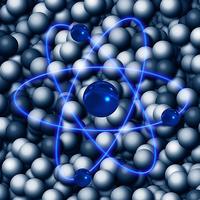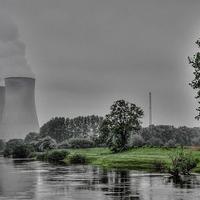What to expect
This topic is a whopper for new key words and there is a lot to memorise! In atomic physics, consider how we as scientists know (roughly) the structure of the atom, and also how electrons exist outside the nucleus. In nuclear physics, what makes these more or less stable and how are these instabilities resolved? The nucleus isn't the smallest particle either, and nor are protons and neutrons. What exists within?
After studying this topic, you should be able to:
- State why solids are solid when atoms are mostly empty space
- Detail the fundamental forces of nature
- Explain why a single quark hasn't ever been observed
- Discuss how nuclei can release energy to become more stable
The Higher Level content includes the determination of the radius and exponential nature of decay for nuclei as well as quantum physics: the photoelectric effect and photons, wave particle duality and atomic models.

Key questions
What was Rutherford's experiment and what did he discover?
Nuclei are heavy (since they don't move when alpha particles rebound), positive (since they repel alpha particles) and small (since only a small number of particles are deflected). This model was established as a result of the Geiger Marsden experiment in which alpha particles are deflected by a thin foil of gold atoms. Find out more.
What does the Standard Model tell us?
Putting fundamental particles into groups forms a very neat pattern that helps us to predict interactions: The Standard Model. The Standard Model is organised according to types of particle and their various properties. Find out more.
What are examples of atomic spectra?
When a low pressure gas is excited, the light emitted is made of discrete wavelengths (responsible for distinct colours of visible light). These wavelengths can be split by a prism to give a line spectrum known as an emission spectrum. When white light is absorbed by a gas, the transmitted light has an associated absorption spectrum. To excite an electron from a low level to a high one requires a certain amount of energy. This will only occur if the light shining contains exactly the right amount of wavelength to correspond to this energy. Find out more.
What makes a nucleus stable?
As more and more nucleons combine in the nucleus, the binding energy increases due to the increased presence of the strong force. To determine whether the nucleus of an isotope is stable, we divide the binding energy by the number of nucleons present. Small nuclei are unstable - they would need to gain binding energy to become more stable. Isotopes of iron and nickel are the most stable, with binding energies per nucleon of almost 9 MeV. Very large nuclei are unstable - they would need to lose nucleons to become more stable. Find out more.
Is alpha radiation stronger than gamma?
Alpha particles consist of a helium nucleus. Their relatively large mass and charge mean that they are the most ionising type of radiation. However, this also has the effect that they can only penetrate 2-3 cm of air and they are absorbed fully by a sheet of paper. Beta particles consist of an electron. Electrons are not normally found in the nucleus, but are released during the process of beta decay, when when a neutron changes into a proton plus an electron. Beta particles are absorbed by a sheet of aluminium foil. Gamma particles are photons of high energy electromagnetic radiation (the same as the gamma we are familiar with from the electromagnetic spectrum). Gamma photons are highly penetrating, only absorbed by several metres of concrete or thick sheets of lead. However, they are the least ionising of these three types of radiation. Find out more.
What does the Bohr model explain?
The Bohr model predicts the hydrogen spectrum by applying the equations for circular motion for electron orbits that have quantised angular momentum. Find out more.
What is quantum tunnelling in simple terms?
Tunnelling is the term given to a particle passing through a potential energy barrier without having sufficient energy to surmount the barrier. It is a conceptually similar phenomenon to a ball rolling through a physical tunnel in a hill, rather than being given an energetic kick to climb over. But in quantum tunnelling barriers, no such physical tunnel exists. Find out more.

Atomic models
Models in physics and beyond are used to describe or explain a challenging concept in a more visual or tangible way (e.g. the brain is like a library, electric current is like water flow). The atomic model is the best guess we currently have that explains

Nuclear physics
Nuclear physics is a big topic!

Structure of matter
Matter is vast and varied throughout the universe. Yet, zoom in enough and this complex story has a simple core - the Standard Model.

AHL Quantum
Quantum physics is the study of the smallest objects in the universe: photons of electromagnetic radiation, the wavelengths of electrons and the energy levels of an atom.


 Twitter
Twitter  Facebook
Facebook  LinkedIn
LinkedIn